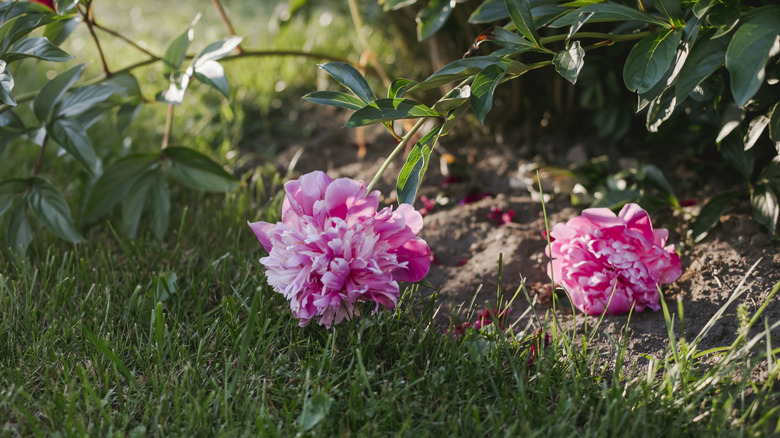Here's Why Your Peonies Keep Falling Over (And How To Fix It)
We may receive a commission on purchases made from links.
Peonies (Paeonia spp.) aren't terribly hard to grow, and a minor struggle is a small price to pay for their huge, fluffy flowers. Avoiding common peony-growing mistakes will put you on the path to success. So will reading up on their quirks. These range from attracting ants to flopping onto the ground. When it comes to flopping, there are a few actions you can take to help your peonies stay upright. Providing more structural support is one option, but also consider a behavioral approach. This means altering their growing conditions so they're not tempted to take a nosedive.
Some peonies can't resist growing flowers that are too bulky for their thin stems to bear. This is especially true for double peonies, which have extra sets of petals. The giant flowers get even harder to hold up as the plants grow taller, sometimes reaching a height of 3 feet. Big rainstorms can intensify the problem, causing a flopping epidemic at this height. Planting varieties known for their compact size or sturdy stems makes flopping less likely. A few peonies that match this description are 'Hillary,' a bushy plant with bright pink blossoms, and 'Eliza Lundy,' a red-flowered variety that tends to stay shorter than 2 feet.
However, don't give up on top-heavy peonies that are already living in your yard. They can be convinced to stand up straight most of the time, sometimes just by pruning off heavy pieces of foliage. Lopping off dead stems also tells your peonies to redirect their energy toward growing vigorous new ones. The best time to do this is early in the spring before the plants shift into growth mode.
Improving the posture of your peonies
Many gardeners give their peonies something to lean on so they don't tip over, much as they do with tomatoes. Peony cages and rings are similar to tomato cages but designed for the size and shape of these flowers. Some cages, such as the MTB Supply 5-pack of peony brace rings, feature a metal grid that the flowers grow through as they reach for the sun. You can also fix droopy peonies by tethering them to a trellis – building them a DIY trellis cage with a pool noodle and metal stakes, or using a product such as Tenax Hortonova Plant Trellis Netting. If you go with netting, be sure to keep it taut. Otherwise, it won't be very effective at holding up your plants. It's best to install your peonies' supports near the start of the growing season. This way, you're less likely to break their stems or leaves during setup.
Before investing in a bracing system, ask yourself if your peonies are getting everything they need to grow strong stems. Though peonies can survive in USDA hardiness zones 3 through 8, they might not thrive unless they're receiving at least 6 hours of direct sunlight each day. If you're growing them somewhere that doesn't get this much sun exposure, moving them into the light may help them perk up. Likewise, if you've planted them in a spot that gets battered by rain or wind, transferring them to a more sheltered area could make a big difference. This removes some of the external factors fueling the flopping. Plus, it melts away stress that has been sapping their strength.

